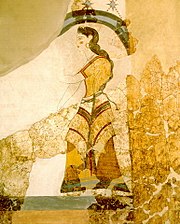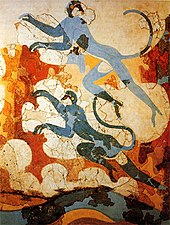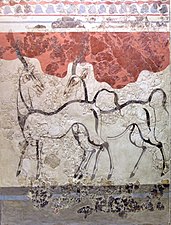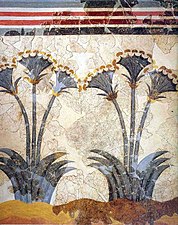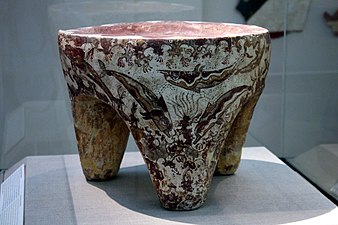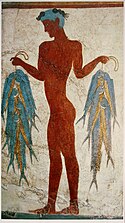Akrotiri (Santoryn)

Akrotiri – wieś na greckiej wyspie Santoryn (Cyklady), na terenie której znajdowało się starożytne miasto, zniszczone przez wybuch wulkanu pod koniec XVII wieku p.n.e. Aktualnie stanowisko archeologiczne, znane z bardzo dobrze zachowanych świadectw życia codziennego jego starożytnych mieszkańców.
Pierwsze wykopaliska rozpoczęto w XIX wieku, jednakże regularne prace zaczęły się w 1967 pod kierownictwem Spyridona Marinatosa. Do roku 2006 odkopano 12 domów, solidnie zbudowanych z ciosów kamiennych, mających do 3 kondygnacji. Znaleziono również pozostałości waz minojskich i mebli oraz inskrypcje w piśmie linearnym B. Najciekawsze są bardzo dobrze zachowane freski przedstawiające najczęściej sceny z życia codziennego – jeden z najbardziej znanych przedstawia dwóch chłopców niosących ryby. Pierwsza odnaleziona osada datowana jest IV tysiąclecie p.n.e., natomiast szczyt rozwoju miasta przypada na okres pomiędzy XX a XVI wiekiem p.n.e. W tym okresie miasto obejmowało obszar ponad 20 ha i miało kilka tysięcy mieszkańców, zajmujących się głównie handlem. Ulice były wąskie, mieszkania jednak obszerne, zbudowane z cegły glinianej, z gipsowanymi ścianami, toaletami połączonymi z kanalizacja miejską. Do niektórych domów doprowadzone były dwie rury z wodą, prawdopodobnie w jednej z nich była ciepła woda pochodząca ze źródeł termalnych.
Malowidła z Akrotiri
Bibliografia
- Levy Joel: Zaginione miasta starożytności. Poznań: Elipsa Publicat, 2008, s. 66–71. ISBN 978-83-245-9557-0.
Media użyte na tej stronie
Fresco of saffron gatherers from the bronze age excavations in Akrotiri on the greek island of Santorini, Greece.
Fresco of decorative patterns in the form of rosettes from the bronze age excavation at Akrotiri on the island of Santorini, Greece.
Fresco of blue monkeys from the bronze age excavations of Akrotiri on the Greek island of Santorini
Autor: unknown, Licencja: CC BY 2.5
Fresque du Printemps. C'est la seule fresque d'Akrotiri à avoir été trouvée in situ, couvrant trois murs de la même pièce. Elle dépeint un paysage rocheux de l'île, avant l'éruption volcanique : de petits groupes de lis rouges dominent les formations volcaniques rouges et grises, tandis que des hirondelles survolent la scène et annoncent symboliquement la renaissance annuelle de la nature. L'utilisation très riche des couleurs (blanc, rouge, jaune et bleu) et le mouvement créé par le balancement des fleurs dans le vent et le jeu des hirondelles permettent d'attribuer cette fresque au peintre des « Cueilleurs de Crocus ». La pièce avait une étagère, en hauteur sur un mur, et une ouverture menant à une pièce plus petite au nord. Le modèle en plâtre d'un lit provient aussi de cette pièce. Pièce D2, édifice D à Akrotiri.
Autor: Maximilian Dörrbecker, Licencja: CC BY-SA 2.5
Map of Akrotiri in the Bronze Age, ca. 1600 BC
Fresco of a fisherman, Akrotiri, Santorini, Greece. Height: 1.10 m
Autor: Klearchos Kapoutsis from Santorini, Greece, Licencja: CC BY 2.0
"Offering Table with dolphins", Akrotiri, Mature Late Cycladic I Period (17th B.C.) cut from pumice
The decline or the flourishing?Young boxers fresco, Akrotiri, Greece. This fresco depicts two naken children wearing a belt and boxing gloves. Their head is shaved, excepted two long locks on the back, and two shorter on the forehead. Their dark skin indicates their gender. The boy at left is more reserved, and wears jewelry (bracelets, necklace) which indicates a high social status. Work from the same artist of the Antilops fresco. Room B1, building B in Akrotiri.
Autor: unknown, Licencja: CC BY 2.5
Fresque des Antilopes. Les deux antilopes sont dessinées à l'aide de lignes foncées appuyées sur un fond de plâtre blanc. Leurs figures sont simples et leurs mouvements expressifs. La fresque appartenait à la même pièce que celle des boxeurs, et peut-être à une composition plus complexe mêlant des figures humaines et animales. Pièce B1, édifice B à Akrotiri.
Autor: F. Eveleens, Licencja: CC BY 2.5
Archaeological site in Akrotiri, Santorini (ancient Thera)



